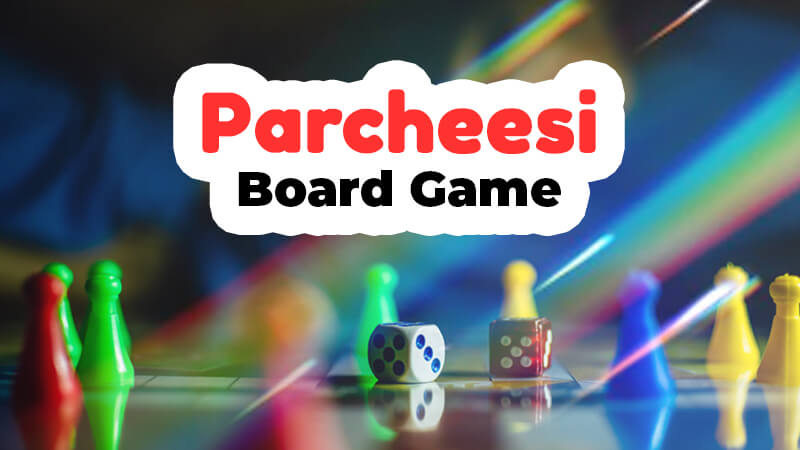Parcheesi Board Game

Table of Contents
Parcheesi is a classic board game that originated in India but has since gained popularity worldwide. It is similar to board games like “Parchisi”, “Ludo”, and “Mensch ärgere Dich nicht”. The game is typically played by two to four players and is characterized by its race-style gameplay.
The primary objective of Parcheesi is to move your pieces around the game board and safely get them into the central home area. Each player has four pieces, and the board features a track around the edge with corner spaces and home paths leading to the central end space. The game is played with two dice, and players take turns rolling the dice to move their pieces.
Setup
The game board itself consists of a continuous track around its periphery, adorned with a total of 68 spaces. Notably, 12 of these spaces are designated as darkened safe spaces, adding an element of strategic importance. Each corner of the board serves as one player’s nest or starting area, contributing to the unique dynamics of the game.
Each player places their four single-colored pieces within their respective starting nests. To determine the order of play, each player takes a turn rolling a single die. The player achieving the lowest roll earns the privilege of making the first move. Subsequently, the order of play progresses clockwise, moving to the next player on the left of the current player.
As the game unfolds, pieces make their journey from the nest to the colored starting space situated to the left of the nest. This initial positioning sets the stage for the subsequent movement of pieces, governed by the rules outlined in the following sections.
How to Play Parcheesi Board Game
Here’s a step-by-step breakdown of how to play Parcheesi board game, including the various rules and movements.
- Dice rolling & movement. The first player rolls the dice and depending on the value, moves their pieces around the board. Only pieces not in the nest may move forward on the board. Pieces may only leave the nest with a roll of a five on a single die or the sum of the dice. If not, the player skips their turn until they do.
- Doubles roll. With a roll of doubles, the player makes four moves, one for each of the numbers on top of the two dice and one for each of the numbers on the bottom. The player may distribute these four moves among one, two, three, or four pieces. After a double roll, the player rolls again after moving their pieces.
- Interaction with opponents. When a piece ends its move in the same space as an opponent’s piece, the opponent’s piece is sent back to its nest. A piece may not be placed in a safe space if it is occupied by an opponent’s piece. The exception is the safe space used when a piece leaves its nest — a single piece occupying such a safe space is sent back to its nest when an opponent’s piece leaves the nest and occupies the space.
- Blockades. A blockade is formed when two pieces of a single player occupy the same space. No piece of any player may move through a blockade. Blockade pieces may not be moved forward together with the roll of a double. Another player may break the blockade with the roll of a double one.
- Home row. The home row is the destination of each player’s pieces. The faster they enter the home row, the better, as in the home row every piece is safe from the opponents. However, players are not required to enter their pieces in the home row. Should they wish, they could pass and start another circuit of the board. This could happen voluntarily or as the result of the requirement of the use of the total die roll.
- Ending the game. The game ends when one player manages to enter all their pieces in the home row. This player is the winner.
These rules and movements form the core mechanics of the Parcheesi game, creating an engaging and strategic gameplay experience.
Parcheesi vs. Ludo
Both Parcheesi and Ludo share a common overall objective, and their board layouts bear a striking resemblance. However, beneath these surface similarities lie distinct gaming experiences that set them apart. Here are the most noticeable points to note:
Parcheesi
- Played between 2-4 players.
- Uses 2 dice for piece movement.
- Features a visually minimalist design.
- Offers a wide range of deployable strategies.
- Allows for another turn with double rolls.
- Requires a roll of 5 to release pieces from the starting point.
- Pieces return to their starting position when bumped by an opponent.
Ludo
- Played between 2-4 players.
- Utilizes a single die for piece movement.
- Boasts a more color-centric visual appeal.
- Provides fewer strategic options, relying more on luck.
- Grants an extra turn upon rolling a 6.
- Allows pieces to leave the starting point with a roll of 6.
- Pieces return to their starting position when bumped by an opponent.
The evolution of Parcheesi and Ludo highlights the universal appeal of these games, transcending borders and cultures. Both offer a similar sense of anticipation and rivalry, making them cherished pastimes worldwide.
Subscribe now
Receive updates and latest news about VIP Games. Simply enter your email below and get notified!
You will only receive quality content.
Signing up for newsletters indicates you agree with our Privacy Policy. If you decide that you no longer want to receive a newsletter, you can unsubscribe by clicking the “Unsubscribe” link, located at the bottom of each newsletter.
